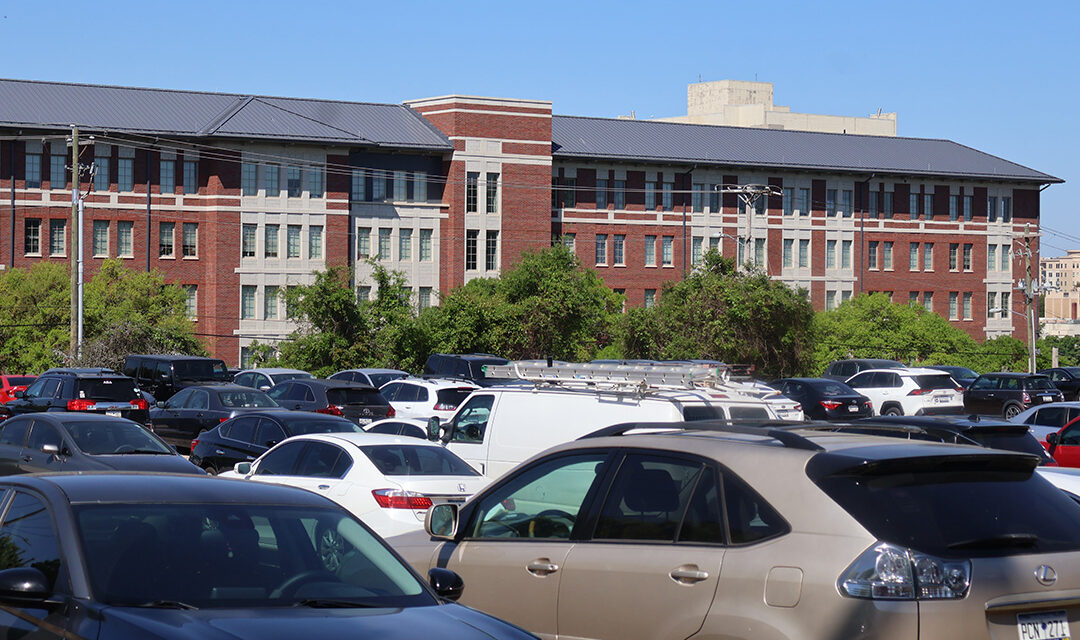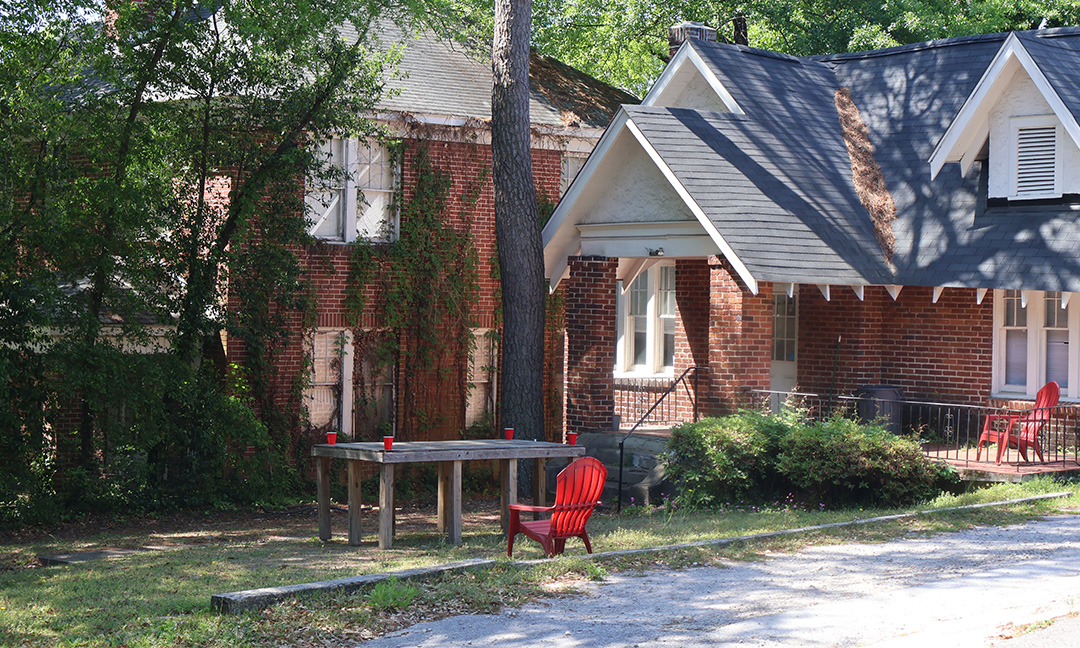Campus Village resident permitted parking next to the Campus Village buildings near the Wheeler Hill neighborhood. Residents with the same permit also can use the garage on the other side of the buildings. (Photos by Emmy Ribero/Carolina News and Reporter)
Neighbors around the city are concerned about USC’s growth and the lack of housing options to accommodate swelling freshman classes.
The University of South Carolina and its students now occupy much of downtown Columbia.
“So much of the housing in the city is now taken up by students, and every time the university adds another 1,000 students, we probably lose 30 houses,” said Kit Smith, Wales Garden neighborhood president. “… The problem is taking housing out of the market that would give us more stability in our neighborhoods with people who would be longer-term residents and (bring) more the culture of the neighborhoods that we’re used to.”
Howard Duvall, a resident of University Hill and a former City Councilman, said his neighborhood has been overtaken by students in need of housing. Homes once owned by families and couples are now occupied by groups of students.
“The lady and her husband across the street and her family put it on the market,” Duvall said of a neighborhood home. “And it actually sold for $35,000 more than the asking price because it got into a bidding war about people who wanted to use it for student housing. So now I have, instead of a residential family, … I have five female students living across the street.”
Duvall said short-term rentals, used for both students and AirBnBs, are driving up the prices in Columbia.
Wales Garden residents are seeing it firsthand.
“If you go up Wheat Street and Saluda, all the way over to Rosewood, … it used to be an area where a lot of faculty lived,” said Louis Dessau, who retired from USC’s business school. “Today, USC faculty can’t afford to live in this area.”
Regardless of how the students make it to the neighborhood, whether through student housing or by renting a home, residents believe students are crowding neighborhoods when they move off campus.
USC spokesperson Collyn Taylor said the university has added more on-campus beds while the university is growing.
“(USC) has increased the number of on-campus beds by over 2,000 in the last five years to 9,445,” Taylor said. “That growth rate of 30.6 percent is almost double the growth rate of the freshman class over that period and significantly more than the growth rate of both the undergraduate and total student population at USC.”
Still, significantly, the university has only enough campus beds for freshmen and few spots for upperclassmen.
Neighborhoods surrounding Campus Village – Wales Garden, Hollywood-Rose Hill and Wheeler Hill – sued the university and the city for breach of agreement over parking and traffic issues in March.
Smith said the lawsuit was a last-ditch effort to get USC officials to talk to neighborhoods about what they plan for the future.
“Because of the breach of trust that we feel like has occurred, we don’t have any confidence in – we can’t get anybody from the university to seriously meet with us and say, ‘Yeah, we did change everything, and we need to sit down and talk about it,’” Smith said.
Smith said the university reached out to the neighborhoods while in the planning process for the $240 million project. But she said those conversations stopped when the university’s plans changed.
Some of the conditions approved by the university and neighborhoods were no longer met, Smith said.
The beds had increased by more than 400, and the parking spaces provided by the garage are now nearly a quarter of what USC earlier agreed to.
Both the city and the university declined to comment on the pending litigation.
Tyler Bailey, a current City Councilmen, said there is friction between neighborhoods and the university. The city is acknowledging this by creating a neighborhood committee which would encourage more communication between the city and neighborhoods.
“There’s a lot of missing information, which is causing a lot of that friction,” Bailey said. “So we need – there needs to be more communication on all levels, the university, to the city developers, to the city developers and the university to the neighborhoods.”
Many residents in Columbia’s neighborhoods are worried about projects in their area whether the project is affiliated with the university or a private developer.
In 2020, an apartment complex was proposed by a developer for south of Rosewood Drive.
There were complications with the project’s zoning because of its proximity to the municipal airport in the neighborhood, leading a city board to reject the plans. However, neighbors spoke out against the plan because of the college renters it would bring to the area, according to the State.
The Rosewood neighborhood, while home to many student rentals, remains mostly untouched by large-scale college development.
Smith said minimizing harm to neighborhoods in Columbia is the responsibility of the university.
“How many more houses are we going to have to lose or potentially lose with the growth of the university?” she said. “And we know that we’re the most vulnerable neighborhoods for that. And we need to protect ourselves, working with the city and the university to stop that from happening.”
Taylor said students living off campus is a “staple of any town with a major university.”
“At USC, we are proud of out students’ contributions to the quality of life in and around Columbia and the enormous impact they have on the vibrancy of the city’s culture as well as its economic growth,” he said.
USC’s freshman class this year is 7,344, out of a student population of more than 36,000. It’s the second year in a row the university has welcomed its largest freshman class.
More growth is expected in the future. The university’s architectural design firm partner, Sasaki, projects the school will grow to 44,000 students by 2033 – a 21% increase. Those numbers are used to make infrastructure project decisions.
In 2016, USC trustee Richard Jones Jr. asked state lawmakers to give him another term. During the required public hearing at the Statehouse, he spoke about the growth of the university as a result to a major cut to collegiate funding at the state level.
“Our business plan is really not a sustainable business plan,” Jones said. “… With the reduction in the amount of funds that we get from the state, we have to make that up in some way. And when we go through the process of making it up, it means more students.”
Jones and Taylor said housing and accommodating the growth is something they are working on now.
“Like most universities, we currently lack enough on-campus housing to meet the demand of every upperclassmen who would prefer living on campus,” Taylor said.





